The Relationship Between Riparian Soil Nutrients and Water Quality in Inlet Sections of Lakes: A Case Study of the Kherlen River
Abstract
1. Introduction
2. Materials and Methods
2.1. Study Area
2.2. Sample Collection and Determination
2.3. The Water Quality Index (WQI)
2.4. Spatial Autocorrelation Analysis
- Global Moran’s I is an index used to measure the degree of aggregation or dispersion of geographical elements within the entire study area. When I-G > 0, it indicates that the elements are positively correlated. When I-G < 0, it suggests a negative correlation between the elements. When I-G = 0, it indicates that the elements are not correlated in the spatial region, meaning they are randomly distributed across the space. The calculation formula is as follows:
- Local Moran’s I can further identify the local aggregation or dispersion characteristics of spatial elements and solve the problem of local spatial heterogeneity ignored by the Global Moran index, so as to more accurately determine the aggregation area of element distribution. When Il > 0, it shows that there is a positive spatial autocorrelation between the elements and the adjacent elements, that is, local spatial agglomeration. When Il < 0, it shows a negative spatial autocorrelation, that is, local spatial dispersion. The calculation formula is as follows:
2.5. Gray Relation Analysis
2.6. Data Processing
3. Results
3.1. Characterization and Spatial Distribution of Water Quality Factors in Lake Inlet Reaches
3.2. Spatial Characteristics of the WQI in the Inlet Reach
3.3. Response of Riparian Soil Nutrients to Inlet Reaches of Lake
3.4. Soil Nutrient Content and Spatial Analysis in Riparian Zones
4. Discussion
4.1. Main Environmental Variables Affecting the Spatial Distribution of Water Quality in the Inlet Section of the Lake
4.2. Main Environmental Variables Affecting the Spatial Distribution of Soil Nutrients
4.3. Analysis of the Relationship Between the WQI in Lake Inlet Sections and Soil Nutrients in the Riparian Zone
5. Conclusions
Author Contributions
Funding
Institutional Review Board Statement
Informed Consent Statement
Data Availability Statement
Acknowledgments
Conflicts of Interest
References
- Huang, J.; Zhang, Y.; Bing, H.; Peng, J.; Dong, F.; Gao, J.; Arhonditsis, G.B. Characterizing the river water quality in China: Recent progress and on-going challenges. Water Res. 2021, 201, 117309. [Google Scholar] [CrossRef] [PubMed]
- Chen, Y.; Guo, J.J.; Cai, G.; Ge, Y.; Liao, Y.; Dong, Z.; Fu, H. Evolution characteristics of submerged macrophyte community diversity in the middle and lower reaches of the Yangtze River in the past seventy years (1954–2021). Biodivers. Sci. 2024, 32, 23319. [Google Scholar] [CrossRef]
- Pandey, S.; Kumari, T.; Verma, P.; Singh, R.; Raghubanshi, A.S. Impact of anthropogenic stresses on riparian ecosystem and their management perspectives. Ecol. Significance River Ecosyst. 2022, 299–324. [Google Scholar] [CrossRef]
- Gumiero, B.; Mant, J.; Hein, T.; Elso, J.; Boz, B. Linking the restoration of rivers and riparian zones/wetlands in Europe: Sharing knowledge through case studies. Ecol. Eng. 2013, 56, 36–50. [Google Scholar] [CrossRef]
- Ghimire, S.R.; Corona, J.; Parmar, R.; Mahadwar, G.; Srinivasan, R.; Mendoza, K.; Johnston, J.M. Sensitivity of Riparian Buffer Designs to Climate Change—Nutrient and Sediment Loading to Streams: A Case Study in the Albemarle-Pamlico River Basins (USA) Using HAWQS. Sustainability 2021, 13, 12380. [Google Scholar] [CrossRef] [PubMed]
- Pachauri, R.K.; Allen, M.R.; Barros, V.R.; Broome, J.; Cramer, W.; Christ, R.; van Ypserle, J.P. Climate Change 2014: Synthesis Report; Contribution of Working Groups I, II and III to the Fifth Assessment Report of the Intergovernmental Panel on Climate Change; IPCC: Geneva, Switzerland, 2014. [Google Scholar]
- Song, W.; Yinglan, A.; Wang, Y.; Fang, Q.; Tang, R. Study on remote sensing inversion and temporal-spatial variation of Hulun lake water quality based on machine learning. J. Contam. Hydrol. 2024, 260, 104282. [Google Scholar] [CrossRef]
- Wu, R.; Zhang, S.; Liu, Y.; Shi, X.; Zhao, S.; Kang, X.; Li, G. Spatiotemporal variation in water quality and identification and quantification of areas sensitive to water quality in Hulun lake, China. Ecol. Indic. 2023, 149, 110176. [Google Scholar] [CrossRef]
- Ren, X.; Yu, R.; Liu, X.; Sun, H.; Geng, Y.; Qi, Z.; Xu, J. Spatial changes and driving factors of lake water quality in Inner Mongolia, China. J. Arid. Land 2023, 15, 164–179. [Google Scholar] [CrossRef]
- Luke, S.H.; Luckai, N.J.; Burke, J.M.; Prepas, E.E. Riparian areas in the Canadian boreal forest and linkages with water quality in streams. Environ. Rev. 2007, 15, 79–97. [Google Scholar] [CrossRef]
- Chang, D.; Lai, Z.Q.; Li, S.; Li, D.; Zhou, J. Critical ource areas’ identification for non-point source pollution related to nitrogen and phosphorus in an agricultural watershed based on SWAT model. Environ. Sci. Pollut. Res. 2021, 28, 47162–47181. [Google Scholar] [CrossRef]
- Tufekcioglu, M.; Zaimes, G.N.; Kahriman, A.; Schultz, R.C. The Relationship between Erosion and Precipitation and the Effects of Different Riparian Practices on Soil and Total-P Losses via Streambank Erosion in Small Streams in Iowa, USA. Sustainability 2024, 16, 8329. [Google Scholar] [CrossRef]
- Wang, X.; Shen, J.L.; Fan, L.; Cai, j. Analysis of the Relationship Between Groundwater Dynamics and Changes in Water and Salt in Soil Under Subsurface Pipe Salt Drainage Technology. Water 2024, 16, 3597. [Google Scholar] [CrossRef]
- Li, J.Y.; Wu, Y.M.; Peng, D.; Chen, M.; Peng, L.; Middleton, B.A.; Lei, T. Spatial Differences in Soil Nutrients Along a Hydrographic Gradient on Floodplains in Dongting Lake. Water 2024, 16, 3674. [Google Scholar] [CrossRef]
- Zhu, N.; Xu, Y.; Wang, X.L.; Feng, A.P.; Huang, L. Simulated Study on Carbon, Nitrogen and Phosphorus Release from the Soils of Water-level-fluctuating Zone in Hulun Lake. Environ. Sci. Technol. 2021, 44, 108–114. (In Chinese) [Google Scholar]
- Lu, X.F.; Guo, Y.N.; Wang, G.X.; Jiang, X.; Wang, K. Distribution characteristics of various forms of phosphorus and the traceability of phosphorus in particulate form in Hulun Lake basin. China Environ. Sci. 2023, 43, 4810–4818. (In Chinese) [Google Scholar]
- Beusen, A.H.W.; Bouwman, A.F.; Van Beek, L.P.; Mogollón, J.M.; Middelburg, J.J. Global riverine N and P transport to ocean increased during the 20th century despite increased retention along the aquatic continuum. Biogeosciences 2016, 13, 2441–2451. [Google Scholar] [CrossRef]
- Zimnicki, T.; Boring, T.; Evenson, G.; Karlen, D.L.; Wilson, R.S.; Zhang, Y.; Blesh, J. On quantifying water quality benefits of healthy soils. BioScience 2020, 70, 343–352. [Google Scholar] [CrossRef]
- Li, L.; Liu, X.; Ge, J.; Chu, X.; Wang, J. Regional differences in spatial spillover and hysteresis effects: A theoretical and empirical study of environmental regulations on haze pollution in China. J. Clean. Prod. 2019, 230, 1096–1110. [Google Scholar] [CrossRef]
- Zhang, X.D.; Cui, J.L.; Xiong, Y.; Zhang, L.Y. Study on the distribution and key influencing factors of Huangtai algae of Ulansuhai Lake. J. Environ. Eng. Technol. 2024, 14, 879–888. (In Chinese) [Google Scholar]
- Yang, W.H.; Chen, A.H.; Li, W.P.; Yu, L.H.; Yin, Z.Y.; Han, P.J.; Duan, H.J. Water quality assessment of Kherlen River and impact analysis of the water environment of Hulun Lake. Environ. Monit. Assess. 2015, 33, 113–116. (In Chinese) [Google Scholar]
- Avery, B.W.; Bascomb, C.L. Soil Survey Laboratory Methods; Digital Library: Paris, France, 1974; No. 6 revised 1987; p. 83. [Google Scholar]
- Wu, Z.S.; Wang, X.L.; Chen, Y.W.; Cai, Y.; Deng, J. Assessing river water quality using water quality index in Lake Taihu Basin, China. Sci. Total Environ. 2018, 612, 914–922. [Google Scholar] [CrossRef] [PubMed]
- Pesce, S.F.; Wunderlin, D.A. Use of water quality indices to verify the impact of Córdoba City (Argentina) on Suquía River. Water Res. 2000, 34, 2915–2926. [Google Scholar] [CrossRef]
- Sun, W.; Xia, C.Y.; Xu, M.Y.; Guo, J.; Sun, G. Application of modified water quality indices as indicators to assess the spatial and temporal trends of water quality in the Dongjiang River. Ecol. Indic. 2016, 66, 306–312. [Google Scholar] [CrossRef]
- Jiao, S.; Li, X.; Yu, J.; Lyu, M.; Zhang, K.; Li, Y.; Shi, P. Multi-Scale Analysis of Surface Building Density and Land Subsidence Using a Combination of Wavelet Transform and Spatial Autocorrelation in the Plains of Beijing. Sustainability 2024, 16, 2801. [Google Scholar] [CrossRef]
- Ding, Y.; Zhao, J.Y.; Zhang, J.; Fu, Y.C.; Peng, W.Q.; Chen, Q.C.; Li, Y.Y. Spatial differences in water quality and spatial autocorrelation analysis of eutrophication in Songhua lake. Environ. Sci. 2021, 42, 2232–2239. (In Chinese) [Google Scholar]
- Chen, Y. Spatial autocorrelation equation based on Moran’s index. Sci. Rep. 2023, 13, 19296. [Google Scholar] [CrossRef] [PubMed]
- Li, H.X.; Han, L.H.; Wei, Q.; Wang, Y.P.; Duan, L.; Xu, L. Assessment on river water ecological health based on gray relation analysis in Liaohe Conservation Area. J. Environ. Eng. Technol. 2020, 10, 553–561. (In Chinese) [Google Scholar]
- Tian, X.; Wang, Z.; Taalab, E.; Zhang, B.; Li, X.; Wang, J.; Ong, M.C.; Zhu, Z. Water Quality Predictions Based on Gray Relation Analysis Enhanced LSTM Algorithms. Water 2022, 14, 3851. [Google Scholar] [CrossRef]
- Yu, Y.Q.; Yu, Y.F.; Peng, L.L.; Yuan, T.T.; Huang, H.; Qiu, T.; Shen, J.J. Evaluation and its differentiation analysis of the coupling coordination relation of agricultural ecology and economy system in the yangtze river basin. Chin. J. Agric. Resour. Reg. Plan. 2022, 43, 235–247. [Google Scholar]
- Chang, S. Soil Physicochemical Characteristics and Comprehensive Evaluation of Xilingol Grassland; Inner Mongolia Normal University: Hohhot, China, 2022. (In Chinese) [Google Scholar]
- Li, Y.; Wang, M.; Chen, X.; Cui, S.; Hofstra, N.; Kroeze, C.; Strokal, M. Multi-pollutant assessment of river pollution from livestock production worldwide. Water Res. 2022, 209, 117906. [Google Scholar] [CrossRef] [PubMed]
- Han, X.H.; Yang, C. An analysis of the self-purification function of Hulun Lake and its effect on regional environmental conservation. J. Nat. Resour. 2002, 06, 684–690. (In Chinese) [Google Scholar]
- Yu, H.F.; Shi, X.H.; Sun, B.; Zhao, S.N.; Liu, Y.; Zhao, M.L. Analysis of water quality and eutrophication changes in Hulun Lake from 2011 to 2020. Arid. Zone Res. 2021, 38, 1534–1545. (In Chinese) [Google Scholar]
- Zhang, L.; Zhang, S.; Sun, B.; Zhao, S.N.; Tian, Y.; Zhao, S.X. Analysis of variation factors of Hulun lake area by using water balance method. J. Water Resour. Water Eng. 2016, 27, 80–85. (In Chinese) [Google Scholar]
- Gerke, J. Improving Phosphate Acquisition from Soil via Higher Plants While Approaching Peak Phosphorus Worldwide: A Critical Review of Current Concepts and Misconceptions. Plants 2024, 13, 3478. [Google Scholar] [CrossRef]
- Jaman, M.S.; Yu, Q.; Xu, C.; Jamil, M.; Ke, Y.; Yang, T.; Wu, H. Chronic drought decreased organic carbon content in topsoil greater than intense drought across grasslands in Northern China. Geoderma 2024, 443, 116832. [Google Scholar] [CrossRef]
- Tang, B.; Rocci, K.S.; Lehmann, A.; Rillig, M.C. Nitrogen increases soil organic carbon accrual and alters its functionality. Glob. Change Biol. 2023, 29, 1971–1983. [Google Scholar] [CrossRef]
- Su, H.H.; Zang, Z.H.; She, Y.D.; Ma, L.; Mao, X.F.; JIA, S.B.; Ma, Z.; Zhou, H.K.; Huang, X.T. Effects of different managements on soil nutrients in alpine grassland in the Qinghai Lake basin. Acta Agrestia Sin. 2022, 30, 1071–1076. [Google Scholar]
- Guo, B.X.; Zhou, J.; Zhan, L.Q.; Wang, Z.Y.; Wu, W.; Liu, H.B. Spatial and Temporal Variability of Soil pH, Organic Matter and Available Nutrients (N, P and K) in Southwestern China. Agronomy 2024, 14, 1796. [Google Scholar] [CrossRef]
- Hou, W.; Wang, H.; Meng, H.; Ning, Y.; Zhao, H.; Cui, X. Nonpoint source pollution and its relationship with soil organic carbon, nitrogen and phosphorus of the riparian zone in the Sunxi river watershed. Res. Soil Water Conserv. 2024, 31, 117–125. (In Chinese) [Google Scholar]
- Sun, S.; Liu, X.; Zhu, X.; Duan, X.; Han, H. Research progress on migration and leaching law of dissolved organic carbon and nitrogen in farmland. J. Shanxi Agric. Sci. 2022, 50, 1158–1167. (In Chinese) [Google Scholar]
- Zhou, H.; Wu, B.; Chen, P.; Jian, Y.; Deng, J.; Song, C.; Yang, Y.; Wang, G.; Sun, S. Characteristics of soil carbon and nitrogen leaching and transport on slopes under hydraulic erosion. Chin. J. Agrometeorol. 2024, 45, 943–952. (In Chinese) [Google Scholar]
- Liu, L.; Zheng, X.; Wei, X.; Kai, Z.; Xu, Y. Excessive application of chemical fertilizer and organophosphorus pesticides induced total phosphorus loss from planting causing surface water eutrophication. Sci. Rep. 2021, 11, 23015. [Google Scholar] [CrossRef]
- Li, M.; Liu, J.; Wang, J.; Song, Z.; Bouwman, A.F.; Ran, X. Phosphorus depletion is exacerbated by increasing nitrogen loading in the Bohai sea. Environ. Pollut. 2024, 352, 124119. [Google Scholar] [CrossRef]
- Liu, Z.X. Spatial and Temporal Characteristics of Phytoplankton Functional Groups and Relationship with Water Environment Factors in the Main Rivers of Hulun; Northeast Forestry University: Harbin, China, 2023. (In Chinese) [Google Scholar]
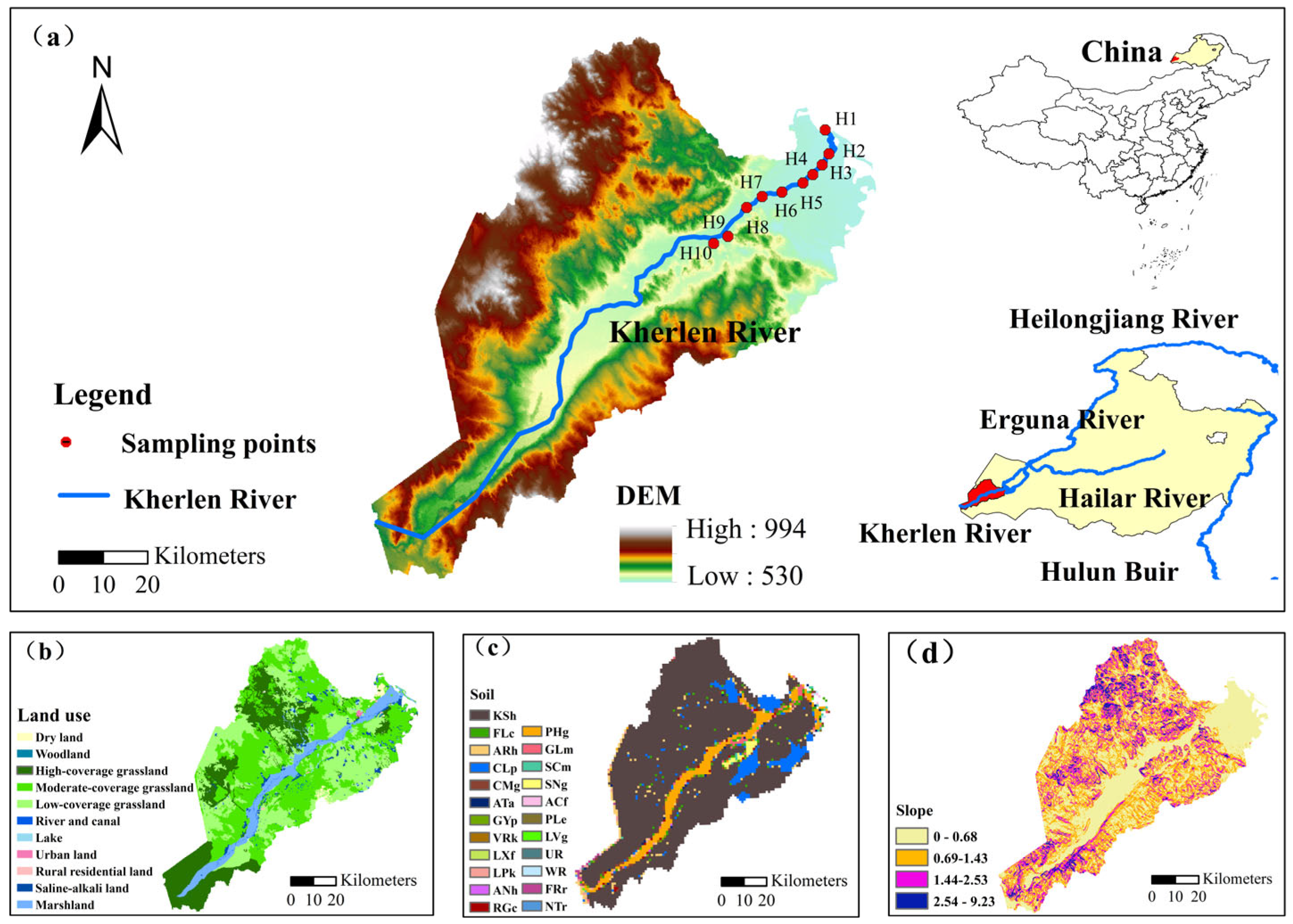
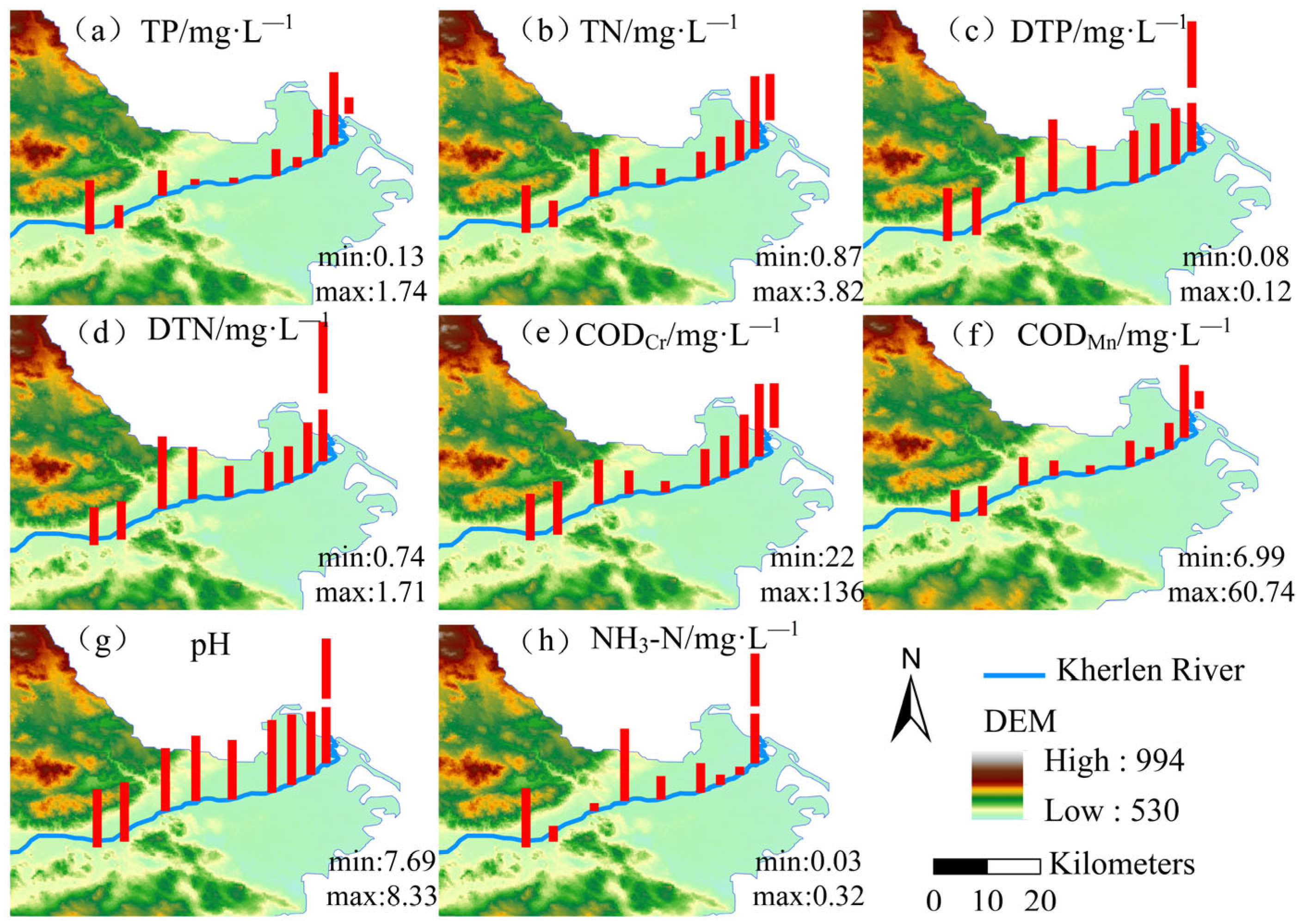
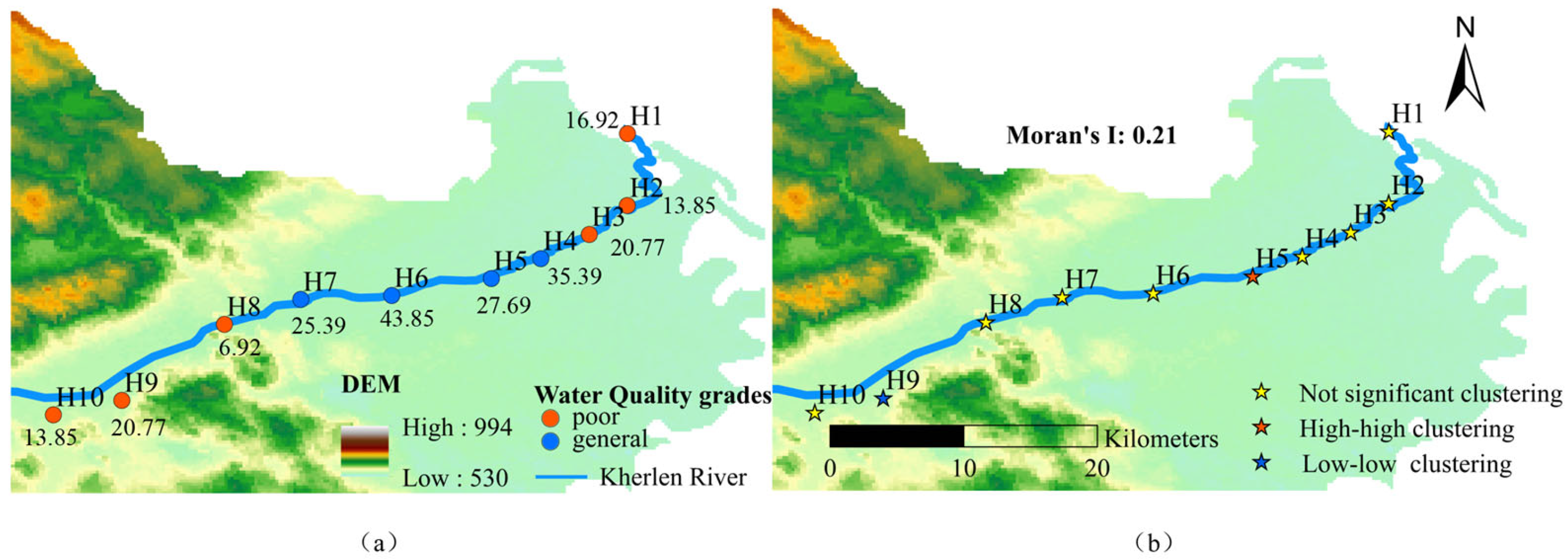

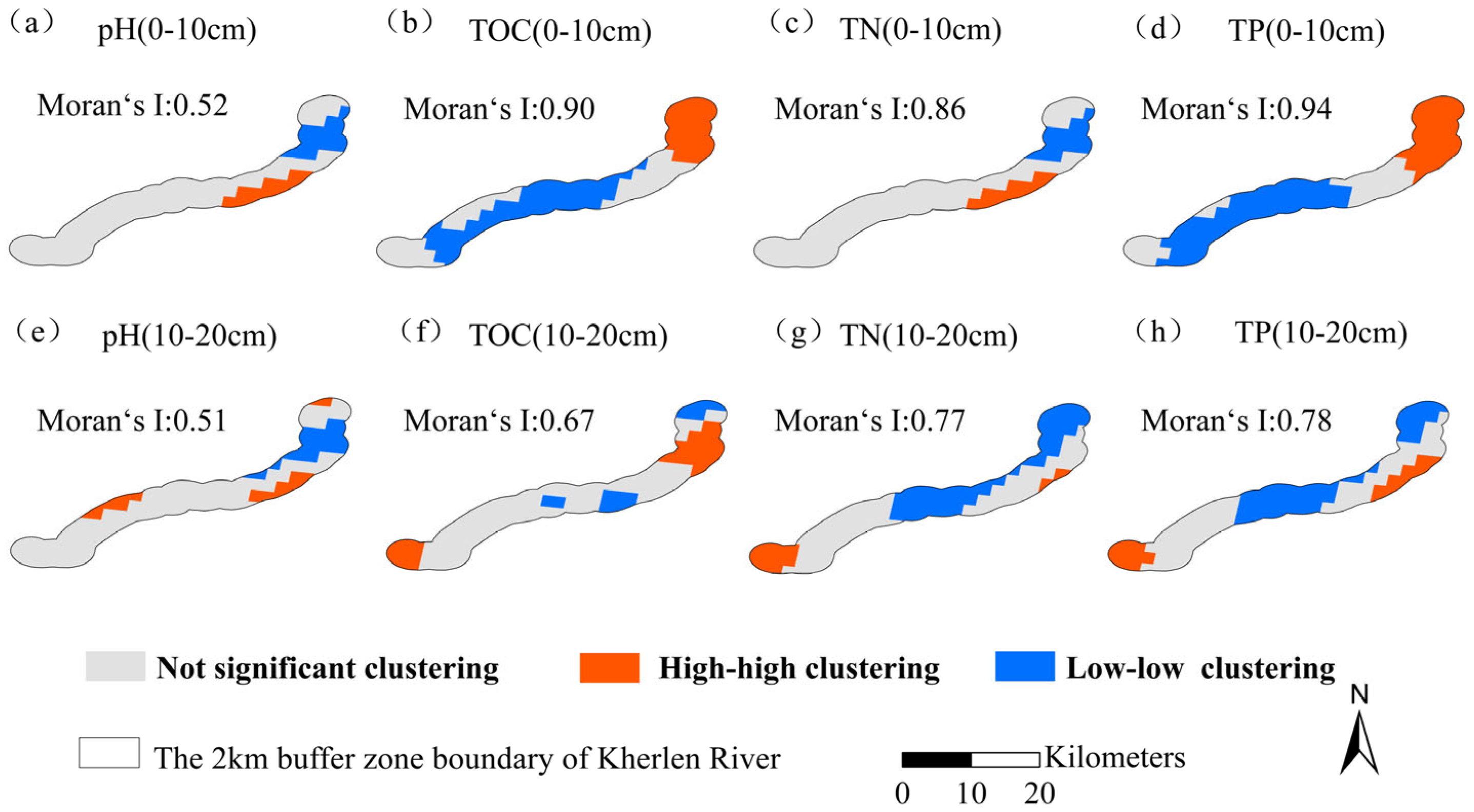
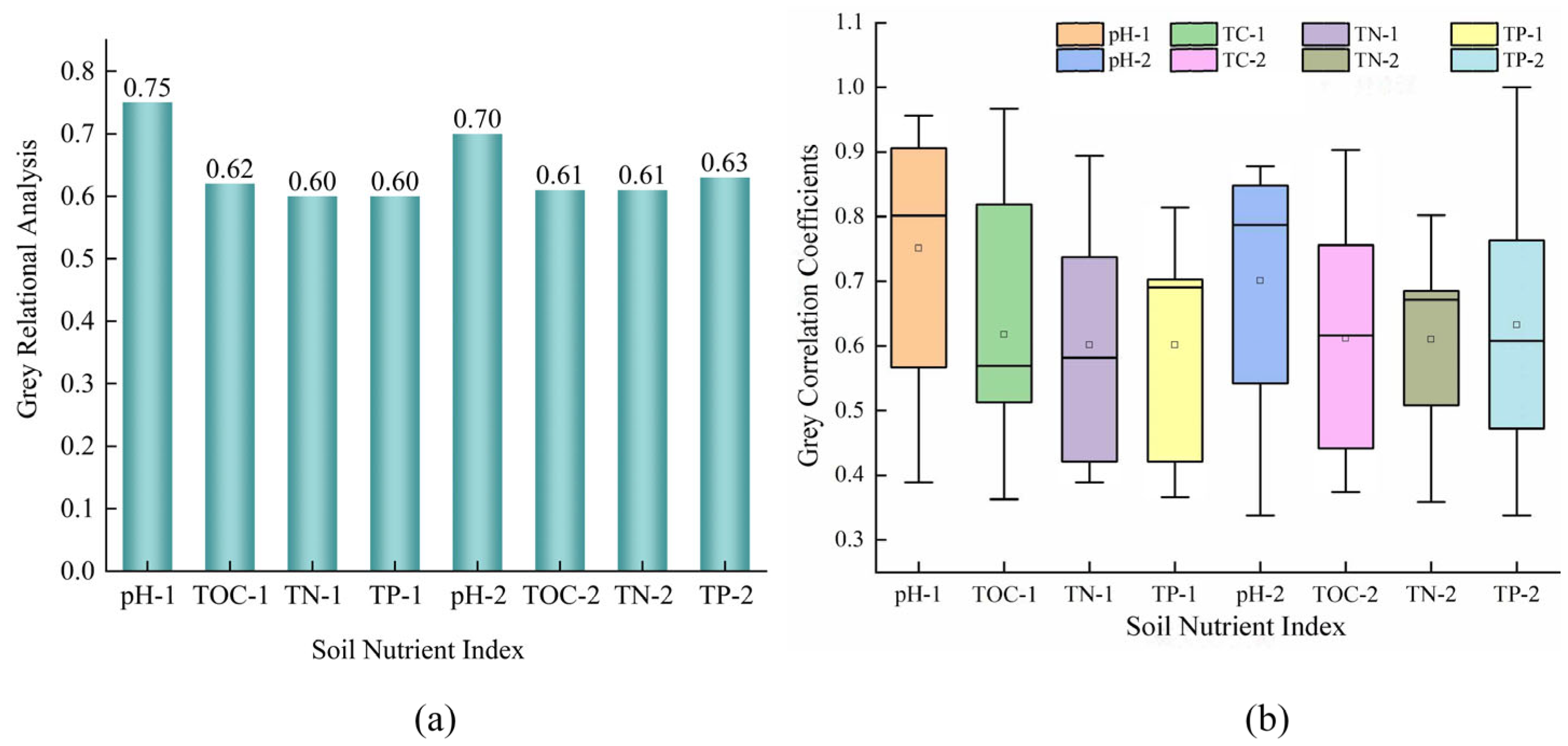
| Weight | 100 | 90 | 80 | 70 | 60 | 50 | 40 | 30 | 20 | 10 | 0 | |
|---|---|---|---|---|---|---|---|---|---|---|---|---|
| TP | 1 | <0.01 | <0.02 | <0.05 | <0.1 | <0.15 | <0.2 | <0.25 | <0.3 | <0.35 | ≤0.4 | >0.4 |
| TN | 3 | <0.1 | <0.2 | <0.35 | <0.5 | <0.75 | <1 | <1.25 | <1.5 | <1.75 | ≤2 | >2 |
| CODMn | 3 | <1 | <2 | <3 | <4 | <6 | <8 | <10 | <12 | <14 | ≤15 | >15 |
| CODCr | 3 | <15 | <16 | <18 | <19 | <20 | <25 | <30 | <35 | <37 | ≤40 | >40 |
| NH3-N | 3 | <0.01 | <0.05 | <0.1 | <0.2 | <0.3 | <0.4 | <0.5 | <0.75 | <1 | ≤1.25 | >1.2 |
| Water Quality Factors | Mean ± Standard Deviation | Measured Value Range |
|---|---|---|
| WT/°C | 24.97 ± 1.12 | 23.10~26.40 |
| pH | 7.98 ± 0.22 | 7.69~8.33 |
| TDS/mg·L−1 | 202.05 ± 62.49 | 167.05~364.00 |
| SAL/‰ | 0.16 ± 0.05 | 0.13~0.30 |
| ORP/mv | −69.78 ± −27.38 | −133.60~−34.80 |
| CODMn/mg·L−1 | 22.42 ± 15.09 | 6.99~60.74 |
| TP/mg·L−1 | 0.69 ± 0.54 | 0.13~1.74 |
| TN/mg·L−1 | 2.04 ± 0.83 | 0.87~3.82 |
| DTP/mg·L−1 | 0.09 ± 0.01 | 0.08~0.12 |
| DTN/mg·L−1 | 1.13 ± 0.34 | 0.74~1.71 |
| CODcr/mg·L−1 | 80.3 ± 31.24 | 22.00~136.00 |
| NO3/mg·L−1 | 0.30 ± 0.10 | 0.13~0.47 |
| F-/mg·L−1 | 0.74 ± 0.20 | 0.55~1.24 |
| NH3-N/mg·L−1 | 0.15 ± 0.11 | 0.03~0.32 |
| NIT/mg·L−1 | 0.08 ± 0.00 | 0.08~0.09 |
Disclaimer/Publisher’s Note: The statements, opinions and data contained in all publications are solely those of the individual author(s) and contributor(s) and not of MDPI and/or the editor(s). MDPI and/or the editor(s) disclaim responsibility for any injury to people or property resulting from any ideas, methods, instructions or products referred to in the content. |
© 2025 by the authors. Licensee MDPI, Basel, Switzerland. This article is an open access article distributed under the terms and conditions of the Creative Commons Attribution (CC BY) license (https://creativecommons.org/licenses/by/4.0/).
Share and Cite
Zhao, Y.; Sun, B.; Shi, X.; Tao, Y.; Wang, Z.; Wang, S.; Ye, B. The Relationship Between Riparian Soil Nutrients and Water Quality in Inlet Sections of Lakes: A Case Study of the Kherlen River. Sustainability 2025, 17, 1367. https://doi.org/10.3390/su17041367
Zhao Y, Sun B, Shi X, Tao Y, Wang Z, Wang S, Ye B. The Relationship Between Riparian Soil Nutrients and Water Quality in Inlet Sections of Lakes: A Case Study of the Kherlen River. Sustainability. 2025; 17(4):1367. https://doi.org/10.3390/su17041367
Chicago/Turabian StyleZhao, Yunliang, Biao Sun, Xiaohong Shi, Yulong Tao, Zenglong Wang, Shihuan Wang, and Bowen Ye. 2025. "The Relationship Between Riparian Soil Nutrients and Water Quality in Inlet Sections of Lakes: A Case Study of the Kherlen River" Sustainability 17, no. 4: 1367. https://doi.org/10.3390/su17041367
APA StyleZhao, Y., Sun, B., Shi, X., Tao, Y., Wang, Z., Wang, S., & Ye, B. (2025). The Relationship Between Riparian Soil Nutrients and Water Quality in Inlet Sections of Lakes: A Case Study of the Kherlen River. Sustainability, 17(4), 1367. https://doi.org/10.3390/su17041367






